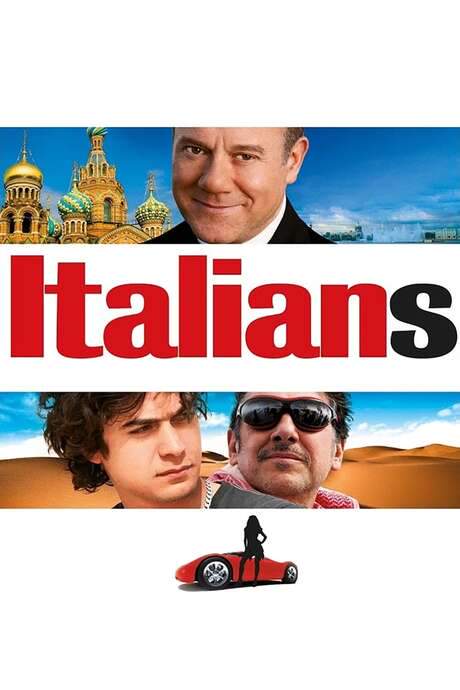
The Law Is the Law
Year: 1958
Runtime: 86 mins
Language: French
Director: Christian-Jaque
In the fictional border town of Assola, the national line slices through the streets, putting Italy and France side by side. French customs officer Ferdinand pursues Italian smuggler Giuseppe, sparking cat‑and‑mouse encounters. The chase changes when Giuseppe learns Ferdinand was born in Italy, making his French customs authority dubious and highlighting a comic take on border politics.
Warning: spoilers below!
Haven’t seen The Law Is the Law yet? This summary contains major spoilers. Bookmark the page, watch the movie, and come back for the full breakdown. If you're ready, scroll on and relive the story!
The Law Is the Law (1958) – Full Plot Summary & Ending Explained
Read the complete plot breakdown of The Law Is the Law (1958), including all key story events, major twists, and the ending explained in detail. Discover what really happened—and what it all means.
In Assola, a village split by the French-Italian border, Giuseppe La Paglia, portrayed by Totò, and Ferdinand Pastorelli, portrayed by Fernandel, wage a persistent and witty game of cat-and-mouse across the line that halves the town. The chase is relentless: Giuseppe’s Neapolitan instincts push him to smuggle goods, while Ferdinand, a diligent French customs officer, pursues him at every turn. Their ongoing tug-of-war becomes the heartbeat of the community, a daily ritual that shapes how people on both sides of the border see themselves and their loyalties.
On a day of celebration on the French side, Ferdinand finally closes in on Giuseppe. A high-energy pursuit ends with Giuseppe under custody, and Ferdinand arrives late to the traditional parade where he was meant to carry the French flag. The arrest becomes a catalyst for a larger unraveling of identity and belonging that threads through the rest of the story. A reception at the hotel nicknamed the Two Borders—literally cut in half by the boundary—reads like a microcosm of the larger conflict, where the building itself embodies the push and pull of two nations living in one place.
Within this tense atmosphere, a striking revelation surfaces: Ferdinand was born in the kitchen of the hotel’s Italian section, to an Italian mother and an unknown father. This discovery challenges Ferdinand’s assumed national identity and calls into question his authority as a French customs officer. As the town’s authorities drill down into the birth records, it becomes clear that the very border regime is haunted by irregularities; the man who recorded Ferdinand’s birth had alternately worked across the border, complicating where Ferdinand’s true allegiance should lie. The plot thickens as Ferdinand learns the birth registry was mishandled, prompting a plan that seems simple in theory but perilous in practice: obtain an Italian identity document and pursue French naturalisation to secure a stable life.
Yet the path to legitimacy is fraught with legal peril. A French politician, a friend of Ferdinand’s in‑law, warns that becoming Italian would erase his French nationality, jeopardize his marriage, and even render his child illegitimate. The fallout is immediate and personal: Ferdinand’s situation is scrutinized, and he finds himself entangled in a web of custodial battles that reflect the fragility of citizenship itself. The situation worsens when Italian authorities detain Ferdinand alongside his first wife Antoinette, who, due to Italian divorce laws, becomes a complicated case of bigamy. While Antoinette is released, Ferdinand is treated as a deserter for having served France in the war, a charge that isolates him from both sides of the border.
A desperate turn follows: Ferdinand is jailed, he contemplates despair, and is briefly discouraged before Giuseppe intervenes. The guard’s reconsideration eventually releases Ferdinand, but only after the authorities determine that he is no longer a deserter under Italian law—yet he has lost any secure claim to Italian citizenship. He is escorted to the border, but without documents, he becomes effectively homeless and stateless—caught in a limbo that strips him of both country and home. He withdraws to the mountains, arming himself and plotting a revenge list against those who have wronged him, an act of vigilante despair set against the vast landscape.
Giuseppe, meanwhile, receives a warning and decides to help his friend. He asks the owner of the Two Borders to procure food for Ferdinand, a move that will test loyalties on both sides of the boundary. While gathering supplies, Giuseppe notices on old wine labels a startling clue: the border had been drawn in a way that could reconfigure the hotel’s layout, and the kitchen is, in fact, located on the French side. This discovery implies that the border was, at least in part, manipulated to attract tourists and economic advantage. Confronted with this truth, Giuseppe collaborates with both Italian police and the French gendarmerie to rush to the mountains and reveal the real border arrangement to Ferdinand.
Misunderstanding and fear still threaten the fragile reconciliation. Ferdinand, seeing Giuseppe with those he suspects are enemies, believes he has betrayed him and fires a shot from his rifle. The bullet, however, strikes only a bottle of hidden liquor carried by Giuseppe, causing no harm. In that moment, Ferdinand realizes that his friend did not betray him, and he lowers his weapon. The revelation that Ferdinand was born in France and is entitled to return to his former life finally shifts the balance. The two men are forced to confront their own versions of justice and loyalty as they re-engage with the world beyond their improvised war.
The film returns to its opening premise with a renewed sense of tension: Ferdinand resumes the chase, but this time with a clearer understanding of the true border and the people caught in its wake. The closing beat is a direct address to the audience, as Ferdinand acknowledges the complexity of justice and the price of law, and, in a final flourish, declares the enduring truth that guides him, even as he continues to chase Giuseppe.
the Law is the Law!
Last Updated: October 05, 2025 at 11:25
Unlock the Full Story of The Law Is the Law
Don't stop at just watching — explore The Law Is the Law in full detail. From the complete plot summary and scene-by-scene timeline to character breakdowns, thematic analysis, and a deep dive into the ending — every page helps you truly understand what The Law Is the Law is all about. Plus, discover what's next after the movie.
The Law Is the Law Timeline
Track the full timeline of The Law Is the Law with every major event arranged chronologically. Perfect for decoding non-linear storytelling, flashbacks, or parallel narratives with a clear scene-by-scene breakdown.

Similar Movies to The Law Is the Law
Discover movies like The Law Is the Law that share similar genres, themes, and storytelling elements. Whether you’re drawn to the atmosphere, character arcs, or plot structure, these curated recommendations will help you explore more films you’ll love.
Explore More About Movie The Law Is the Law
The Law Is the Law (1958) Scene-by-Scene Movie Timeline
The Law Is the Law (1958) Movie Characters, Themes & Settings
The Law Is the Law (1958) Spoiler-Free Summary & Key Flow
Movies Like The Law Is the Law – Similar Titles You’ll Enjoy
Down by Law (1986) Ending Explained & Film Insights
The Law (2010) Ending Explained & Film Insights
I due carabinieri (1984) Complete Plot Breakdown
The Lieutenant of the Carabinieri (1986) Plot Summary & Ending Explained
Guardia, guardia scelta, brigadiere e maresciallo (1956) Film Overview & Timeline
Street Law (1974) Detailed Story Recap
The Band of Honest Men (1956) Movie Recap & Themes
In the Name of the Italian People (1971) Complete Plot Breakdown
In the Name of the Law (1949) Movie Recap & Themes
Getting Away with It the Italian Way (1962) Plot Summary & Ending Explained
Italians (2009) Full Summary & Key Details
Cops and Robbers (1951) Full Movie Breakdown
The Law (1959) Full Movie Breakdown
The Sucker (1965) Movie Recap & Themes
I Am the Law (1977) Plot Summary & Ending Explained

















